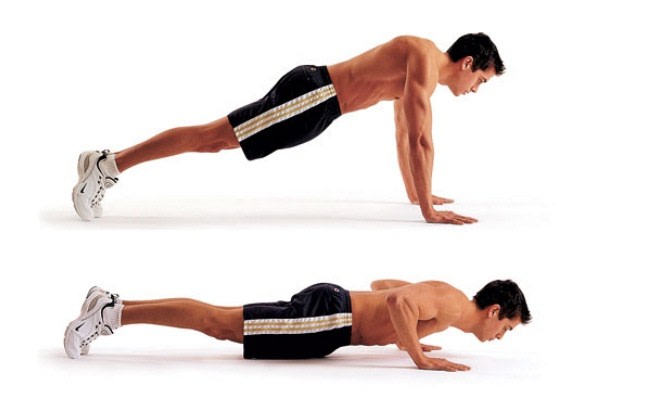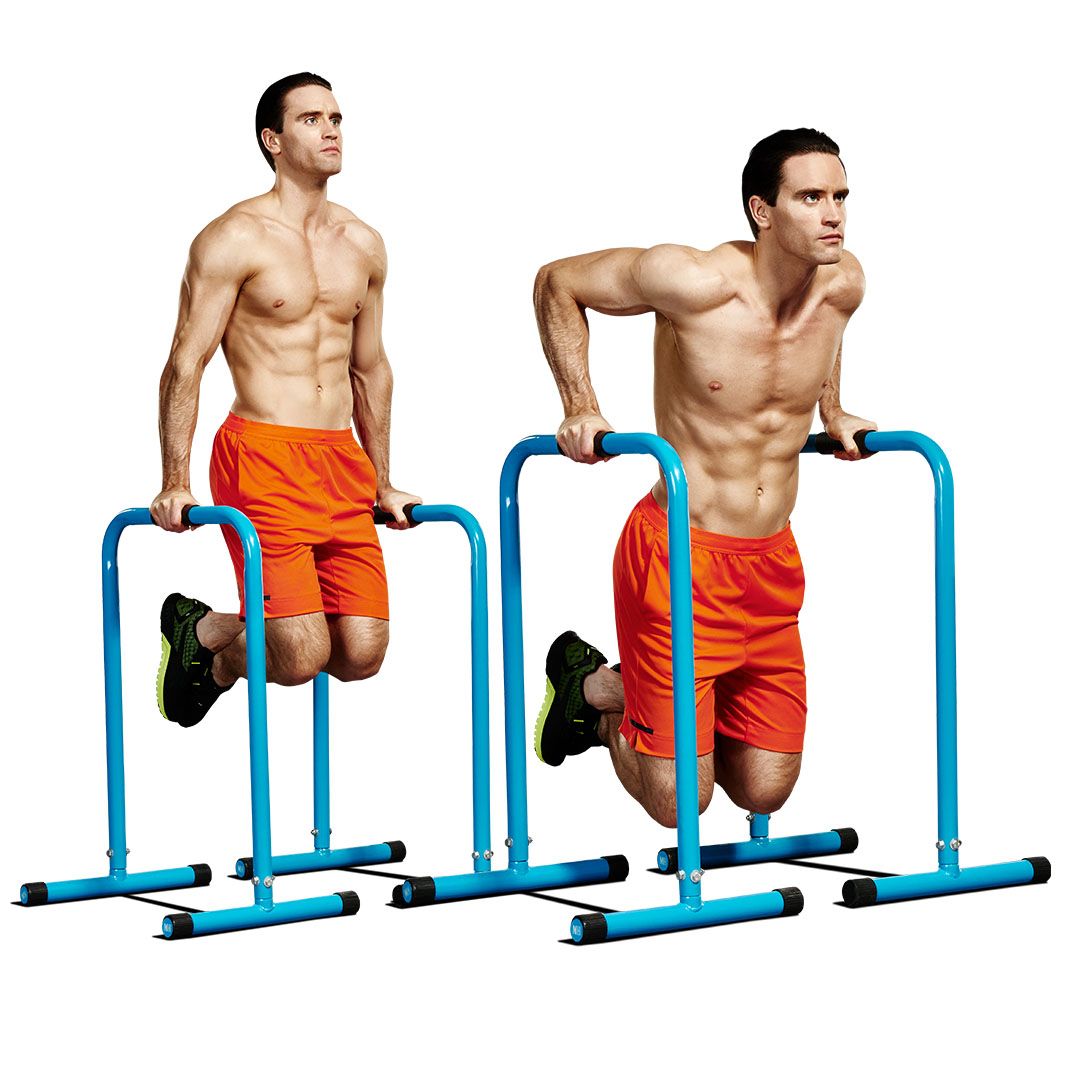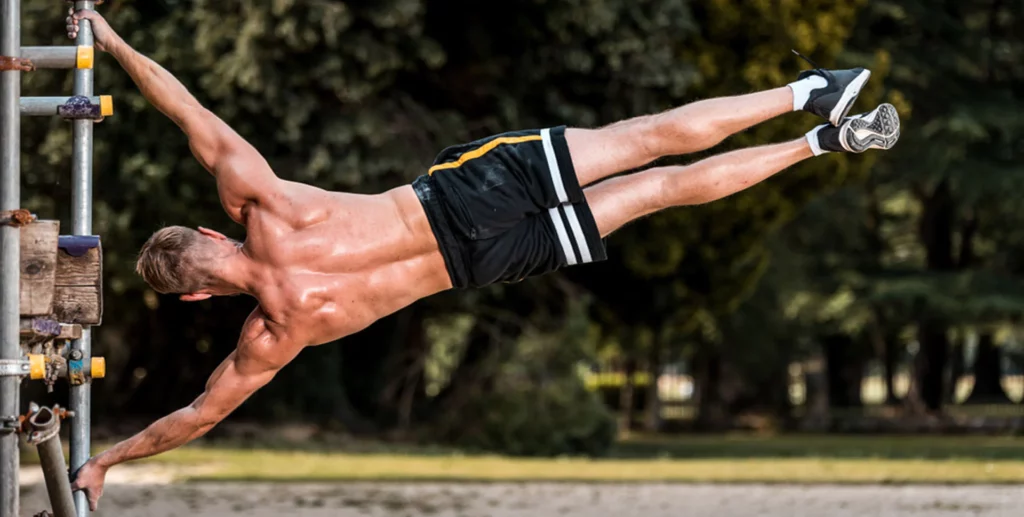1. What is Calisthenics?
Calisthenics is a workout approach that emphasizes using body weight for exercise rather than lifting weights. In this blog, we’ll delve into Calisthenics Push Workout. If you are new to the world of Calisthenics, Read Our Calisthenics Beginner Guide.
2. Importance of Calisthenics Push Workout:
Push exercises serve as the cornerstone for developing upper body strength in calisthenics, targeting key muscle groups like the chest, shoulders, triceps, and core. Integrating Calisthenics Push Workout into your workout routine enhances pushing power, boosts muscular endurance, and ultimately leads to a well-proportioned and chiselled physique.
3. Benefits of a Well-rounded Calisthenics Push Workout Routine:
- Muscle Growth and Definition: Push exercises effectively engage major muscle groups such as the pectoralis muscles, deltoids, and triceps. Consistent training stimulates muscle development, resulting in an aesthetically pleasing and robust upper body.
- Empowering Upper Body Strength: A well-rounded calisthenics push workout routine builds exceptional upper body strength, facilitating ease and efficiency in performing everyday tasks. From pushing objects to carrying heavy loads or excelling in sports activities, a robust upper body is fundamental for peak performance.
- Strengthening Core Stability: Many push exercises demand core engagement to maintain proper form and stability. By fortifying your core during push workouts, you create a sturdy foundation that not only supports other movements but also minimizes the risk of injuries.
- Embracing Functional Fitness: Calisthenics push exercises emulate real-life movements, endowing them with high functionality. This practical approach to training translates to improved performance in various activities, including lifting, pushing, and propelling oneself from different positions.
- Versatility and Accessibility: Push exercises are incredibly versatile and can be adapted to cater to individuals of diverse fitness levels. Ranging from basic push-ups to advanced variations like handstand push-ups or planche progressions, there exist options for beginners, intermediate, and advanced practitioners alike.
- Utmost Convenience: Unlike traditional weightlifting, calisthenics push exercises require no heavy gym equipment and can be performed virtually anywhere. Whether you find yourself at home, travelling, or amidst nature, maintaining your push workout routine becomes effortless.
4. Fundamental Push Exercises:
a. Push-ups:

- Push-ups are a fundamental calisthenics push exercise that targets the chest, shoulders, triceps, and core muscles. They can be modified with various hand placements to emphasize different muscle groups.
- The basic variations of pushups are mentioned below:
Standard Push-ups:
-
- Start in a high plank position with hands slightly wider than shoulder-width apart and aligned with the chest.
- Lower your body by bending the elbows while keeping your core engaged.
- Push back up to the starting position, fully extending your arms.
- Repeat for the desired number of reps.
Diamond Push-ups:
-
- Assume the standard push-up position but bring your hands close together, forming a diamond shape with your index fingers and thumbs.
- Lower your body while keeping the elbows close to your sides.
- Push back up, extending your arms fully.
- This variation places more emphasis on the triceps.
Wide-Grip Push-ups:
-
- Position your hands wider than shoulder-width apart.
- Perform the push-up with your elbows flared out to the sides.
- This variation targets the chest muscles to a greater extent.
b. Dips:

-
-
1. Dips are excellent for targeting the chest, triceps, shoulders, and core muscles. They can 2. be performed on parallel bars or using a bench or chair.
-
Parallel Bar Dips:
-
- Hold onto parallel bars with your arms fully extended.
- Lower your body by bending your elbows until your shoulders are slightly below your elbows.
- Push back up to the starting position, extending your arms fully.
- Maintain an upright torso and engage your core throughout the movement.
Bench Dips:
-
- Position your hands on a bench or sturdy surface behind you, fingers pointing forward.
- Extend your legs out in front, keeping your heels on the floor.
- Lower your body by bending your elbows until your upper arms are parallel to the floor.
- Push back up, fully extending your arms.
- Maintain control and avoid swinging or using momentum.
c. Pike Push-ups:
- Pike push-ups primarily target the shoulders, upper chest, triceps, and core muscles. They are performed in a downward dog-like position.
- Pike Push-ups Guide:
- Start in a high plank position with your hands directly under your shoulders and feet hip-width apart.
- Lift your hips up, creating an inverted “V” shape with your body.
- Bend your elbows and lower your head toward the floor, keeping your neck in line with your spine.
- Push back up to the starting position, extending your arms fully.
- Engage your core and maintain stability throughout the movement.
Muscle Groups Targeted and Benefits:
Push-ups: Target the chest (pectoralis major and minor), shoulders (deltoids), triceps, and core muscles. They improve upper body strength, stability, and muscular endurance.
Dips: Engage the chest, shoulders, triceps, and core muscles. They promote overall upper body strength, particularly in the chest and triceps, while also improving shoulder stability.
Pike Push-ups: Focus on the shoulders (deltoids), upper chest, triceps, and core muscles. They help develop shoulder strength, stability, and overhead pressing ability, mimicking the benefits of a standing shoulder press.
5. Intermediate/Advanced Push Exercises:
a. Handstand Push-ups:
- Handstand push-ups are advanced variations of push-ups that target the shoulders, triceps, and upper chest. They require a high level of strength, balance, and body control.
Wall-Assisted Handstand Push-ups:
-
- Begin in a handstand position facing a wall, with your hands shoulder-width apart and arms fully extended.
- Lower your body by bending your elbows, keeping them close to your sides, until your head lightly touches the floor.
- Push back up to the starting position, fully extending your arms.
- Use the wall for support and balance as you build strength and improve your technique.
Freestanding Handstand Push-ups:
-
- Start in a freestanding handstand position, balancing on your hands.
- Lower your body down while maintaining control and balance, until your head is slightly above the ground.
- Push back up to the starting position, extending your arms fully.
- Freestanding handstand push-ups require exceptional upper body strength, balance, and stability.
b. Planche Progressions:
-
- Planche progressions focus on developing immense upper body and core strength, requiring significant shoulder and tricep engagement. They involve holding a horizontal body position with only the hands touching the ground.
Tuck Planche:
-
- Begin in a squat position and place your hands on the ground, shoulder-width apart.
- Lean forward and shift your weight onto your hands, lifting your feet off the ground.
- Keep your arms straight and try to achieve a horizontal position with your body.
- Start with a tucked position, where your knees are bent and close to your chest, gradually progressing to straightening your legs.
Advanced Tuck Planche:
-
- From the tuck planche position, gradually straighten your legs and lift them higher, achieving a more parallel body position to the ground.
c. One-Arm Push-ups:
One-arm push-ups require significant upper body strength and stability, targeting the chest, shoulders, triceps, and core muscles.
Assisted One-Arm Push-ups:
-
- Assume a push-up position with a slightly wider hand placement.
- Shift your weight to one side and slightly lift the opposite hand off the ground.
- Perform a push-up while focusing on the working arm.
- The non-working arm provides balance and assistance, gradually reducing support over time.
Full One-Arm Push-ups:
-
- Begin in a push-up position and place one hand behind your back.
- Lower your body down by bending your elbow, keeping the arm close to your side.
- Push back up to the starting position, fully extending your arm.
- Maintain control and stability throughout the movement.
Benefits of these Exercises:
Handstand Push-ups: These exercises require exceptional shoulder and tricep strength, balance, and body control. They provide a unique challenge to the upper body muscles, promoting shoulder stability, overhead pressing strength, and muscular development in the shoulders, triceps, and upper chest.
Planche Progressions: Planche progressions demand incredible upper body and core strength, requiring the activation of multiple muscle groups simultaneously. They improve shoulder stability, core strength, and body control, leading to enhanced functional strength and body awareness.
One-Arm Push-ups: One-arm push-ups target the chest, shoulders, triceps, and core muscles, significantly challenging muscular strength and stability. They promote unilateral strength development, balance, and core engagement, resulting in increased upper-body strength and control.
Importance of Progression and Building Strength:
Gradual progression and building strength are crucial when attempting intermediate and advanced push exercises. It is essential to establish a solid foundation with fundamental push exercises and progressively increase the difficulty over time. Rushing into advanced variations without sufficient strength and technique can lead to injuries and setbacks. Focus on proper form, gradually reducing assistance, and increasing the difficulty level as your strength improves. This approach ensures long-term progress and reduces the risk of injury.
6. Calisthenics Leg Workout:
As we know training Legs is also a Pushing Movement but, we don’t recommend that you train legs with other muscle groups that are targeted by push movements. You should do calisthenics leg workout and calisthenics push workout with a minimum of 2 days rest between them. Leg Muscles also known as Quadricep Muscles are one of the largest muscles in our body so, it is recommended that you train them alone on alternate days. If you want a complete Calisthenics Leg Workout Routine you can Check out our Blog: Calisthenics Leg Workout
Conclusion:
Integrating push exercises into your calisthenics regimen is imperative for cultivating fortitude, vigour, and sculpted musculature in the upper physique. From fundamental manoeuvres like push-ups, dips, and pike push-ups to more intricate variations such as handstand push-ups, planche progressions, and one-arm push-ups, a plethora of options abounds to cater to individuals of diverse fitness levels.
By wholeheartedly embracing impeccable form, gradually heightening the level of difficulty, and granting ample room for strength augmentation, you can confidently advance in your training endeavours and unlock the manifold benefits presented by these demanding push exercises. Heightened upper body robustness, enhanced shoulder stability, tricep refinement, core engagement, and elevated mastery over bodily movements are among the bountiful rewards that await you.
Bear in mind that calisthenics is an expedition necessitating patience, unwavering commitment, and steadfast perseverance. Incrementally fostering strength and mastering the nuances of proper technique stand as the cornerstones to ensure optimal outcomes and mitigate the perils of injury. Pay heed to the signals your body imparts, respect its boundaries, and seek the counsel of a proficient fitness expert, should the need arise.
Hello, fellow fitness enthusiasts! I'm Zayn, a Board Certified Fitness and Nutrition Coach. My journey started from a personal commitment to fitness, and over time, this passion ignited a desire to help others unlock their potential. I transformed this passion into my profession, and today, I'm proud to say that I am armed with a plethora of certifications, all testament to my dedication and commitment.
When I'm not advising clients or working on my next blog post, you'll find me trying out new fitness regimes, diving into the latest nutritional research, or practicing what I preach with my own healthy lifestyle. My mission is to help you become the best version of yourself, showing that fitness and nutrition are as much about the journey as they are about the destination.


